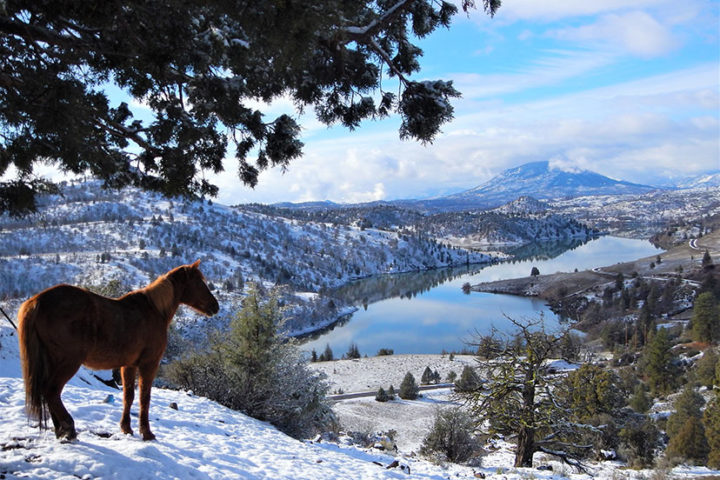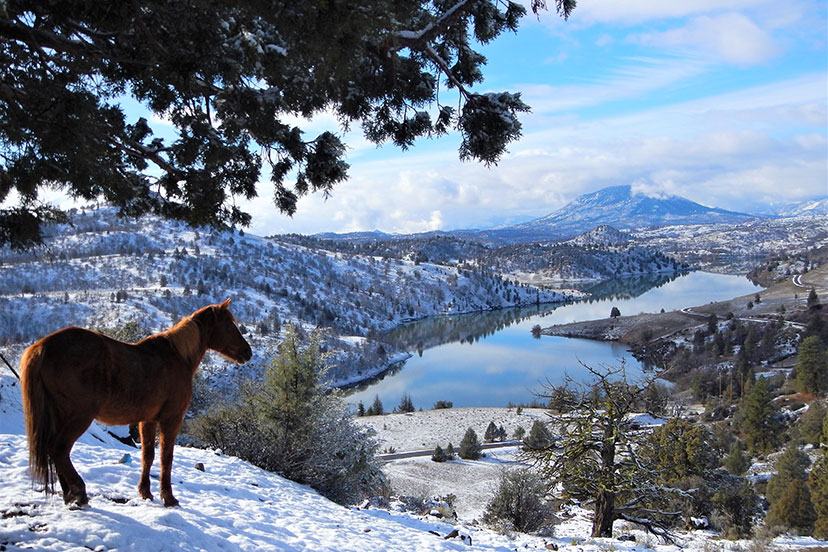American wild horses are vanishing from the American landscape at an unprecedented rate. Why?
Under guidance from Interior Secretary Deb Haaland and executed by the Bureau of Land Management (‘BLM’), wild horses are being rounded up at an alarming rate.
And the few wild horses remaining after the roundups are treated with dangerous chemicals that are couched as ‘contraception’.

It’s a fact that, after this latest second-round of so-called ‘gathers’ in the past year, dubiously claimed as necessary due to the drought, wild horse populations in the west will be taken down to levels that are genetically non-sustainable. In-breeding is now assured.
Compounding what can be argued as genocide, are the supporters of using contraceptive chemicals on wild horses, which are ‘wildlife’. The use of contraceptives such as porcine zona pellucida (‘PZP’) and GonaCon on native species American wild horses is the sham. Deciding which horses will breed and which will not, either by intention or happenstance, is by definition ‘selective breeding’ and is counter to the critical role the natural selection plays in maintaining the genetic vigor of any species of animal.
Science shows that PZP works best on mares with the best immune systems, which presents a serious problem. Mares with poor immune systems can still give birth even after being treated with PZP. This results in selective breeding in favor of foals that likely also carry their mare’s genes for a poor immune system. This stacks the genetic deck against the resulting population of immune-depressed wild horses, which arguable could fall prey to any disease spreading within the herd.
The problem in a nutshell is the media (National Geographic, Discovery, CBS, NBC, ABC, and other national TV, print, online media outlets) have pummeled the court of public opinion, supporting the BLM’s unfounded conjectures and misinformation that ‘wild horses are a menace destroying landscape and are overpopulated’, and ‘have no natural predators’. Both statements are false.
Coupled with that, we have the leading (as in, the loudest) non-profit wild horse advocacy organizations, each self-promoting their own ideas of so-called solutions, which are, in fact, not solutions for a sustainable ‘wild and free’ population of wild horses on the American landscape. There are far too many people with opinions about wild horse management who have never even spent a year living among wild horses to gather the insights needed to discuss their management from a fully-informed perspective.
TV news reports, movies, books, hearsay and field-trips watching them over a sandwich and a telephoto lens, or hanging out with broken-spirited wild horses that have been taken out of nature are not methods suited to learning from them. In order to learn from wild horses, humans who want to learn have to make the requisite sacrifices to live among them as their students without any preconceived notions.
I have spent the last seven years of my life as a student of the free-roaming wild ones here in the Soda Mountain wilderness.
To say the least, sacrifices have been made, and it hasn’t been easy… Even after seven years of four-seasons and many, many moons, I am still learning from the wild ones about how they live and what they want and need as sentient beings with free-will. I have also learned, first-hand from them, that they play a vital role via their co-evolved mutualisms with the flora and fauna that also occupy the ecosystems benefited by the wild ones.
My preliminary study of the ecological benefits of free-roaming wild horses, including reducing the frequency and intensity of wildfires, has been published, yet some non-profits will not publish it, even though they have been granted expressed permission to do so.
However, in Europe, people who apparently aren’t so caught up in money related concerns or ego, have published my study. ReWilding Europe published my study, ‘Impact of Wild Horses on Wilderness Landscape and Wildfire’, at their wildfire-focused web journal GrazeLIFE.
Moreover, complicating matters further are the non-profits who are unwilling to collaborate, and who won’t acknowledge that the socioeconomic changes in America, over the past 50 years since the 1971 WHBPA was passed, have had major impacts on the American landscape, largely due to the consumerism that is practiced by the vast majority of Americans.
Without any doubt, a logical overview calls for a new paradigm in wild horse management that uses modern ecological science coupled with a paleo-ecological overview of suitable areas for wild horse management that are synergised by natural methods and tactics. Enforcing ‘artificial’ methods upon the ‘natural’ world suggests an approach based in ignorance.
And this is exactly why we find ourselves living in the dung-heap of our folly, and on a planet that we are slowly destroying due to the ignorance, greed and ego of humankind.
Wild horses have been good, steadfast stewards of the natural world over the course of their 55 million years of evolution on this planet. It’s sad that some wild horse non-profits share responsibility, to one degree or another, in the demise of American wild horses via their continuing to offer non-natural measures that have now taken American wild horses right to the brink of extinction.
In the waning moments of the sad story of America’s wild horses, we can only hope that non-profits step back from their currently flawed beliefs, and make the required radical change off the path they are currently on, as the last sands of wild horse survival pass through the hourglass.
William E. Simpson II is a naturalist, author, and conservationist living in the Soda Mountain wilderness area among the wild horses that he studies. Learn more at Wild Horse Fire Brigade.

